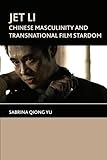Jet Li : Chinese Masculinity and Transnational Film Stardom / Sabrina Qiong Yu.
Material type: TextPublisher: Edinburgh : Edinburgh University Press, [2022]Copyright date: ©2012Description: 1 online resource (224 p.) : 10 B/W illustrationsContent type:
TextPublisher: Edinburgh : Edinburgh University Press, [2022]Copyright date: ©2012Description: 1 online resource (224 p.) : 10 B/W illustrationsContent type: - 9780748645473
- 9780748645480
- 791.43028092 23
- online - DeGruyter
| Item type | Current library | Call number | URL | Status | Notes | Barcode | |
|---|---|---|---|---|---|---|---|
 eBook
eBook
|
Biblioteca "Angelicum" Pont. Univ. S.Tommaso d'Aquino Nuvola online | online - DeGruyter (Browse shelf(Opens below)) | Online access | Not for loan (Accesso limitato) | Accesso per gli utenti autorizzati / Access for authorized users | (dgr)9780748645480 |
Frontmatter -- Contents -- Illustrations -- Acknowledgements -- Introduction: Jet Li and transnational kung fu stardom -- Part I Jet Li as Chinese wuxia hero -- 1 Jet Li and the new wuxia cinema in the 1990s -- 2 Kung fu master: martial arts and acting in Once Upon a Time in China (1991) -- 3 Gay lover? Gender trouble and male identifi cation in Swordsman II (1992) -- 4 Mother’s boy: adolescent hero and male masquerade in Fong Sai-yuk (1993) -- Part II Jet Li as transnational kung fu star -- 5 Villain/killer/child: crossover images and Orientalist imagination -- 6 Asexual Romeo? Male sexuality and cultural perspectives -- 7 National hero/spectacular body: national and transnational identities -- 8 Borderless icon: star construction and Internet fandom -- Conclusion -- Bibliography -- Index
restricted access online access with authorization star
http://purl.org/coar/access_right/c_16ec
Jet Li's career has crossed numerous cultural and geographic boundaries, from mainland China to Hong Kong, from Hollywood to France. In Jet Li: Chinese Masculinity and Transnational Film Stardom, Sabrina Qiong Yu uses Li as an example to address some intriguing but under-examined issues surrounding transnational stardom in general and transnational kung fu stardom in particular.Presenting case studies of audiences' responses to Jet Li films and his star image, this book explores the way in which Li has evolved from a Chinese wuxia hero to a transnational kung fu star in relation to the discourses of genre, gender, sexuality, ethnicity and national identity. By rejecting a text-centred approach which prevails in star studies and instead emphasising the role of audiences in constructing star image, this book challenges some established perspectives in the study of Chinese male screen images and martial arts/action cinema.
Mode of access: Internet via World Wide Web.
In English.
Description based on online resource; title from PDF title page (publisher's Web site, viewed 29. Jun 2022)


